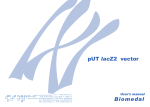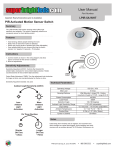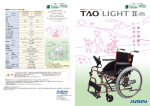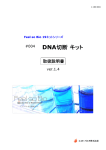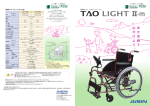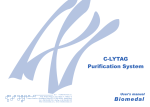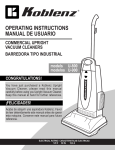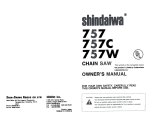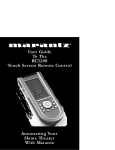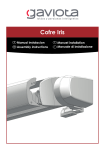Download PANC 1.FH11
Transcript
PANC-1 mini-Tn5 package Ed. 1 Web: www.biomedal.com . © 2006 Biomedal, S.L. Email: [email protected] User's manual Biomedal NOTES PANC-1 mini-Tn5 package A colletion od Delivery System pUT mini-Tn5 plasmids carrying antibiotic selection markers and donor and helper strains. For research use only 4. Vectors Maps .................................................................7 PANC-1 mini-Tn5 package Contents 5. Restriction analysis .....................................................9 5.1. pUTmini-Tn5 Cm Restriction analysis .................9 5.2. pUTmini-Tn5 Km Restriction analysis ..................9 5.3. pUTmini-Tn5 Sm/Sp Restriction analysis ............10 5.4. pUTmini-Tn5 Tc Restriction analysis ...................10 1 1. Product Description ....................................................2 2. Vectors .....................................................................3 2.1.1. pUTmini-Tn5 vectors ..............................................3 3. About mini-Tn5 System ...............................................4 24 6. Protocol ...................................................................11 6.1. Cloninig and transformation of donor strain...........11 6.2. Transfer of the DNA into the recipient strain..........12 6.3. Selection of exconjugants .......................................14 7. Troubleshooting ........................................................16 8. Reagents and recipes ................................................17 9. References ...............................................................19 10. Related products .............................................................21 11. Short protocol ............................................................22 www.biomedal.es NOTES 1. Product Description. KIT COMPONENTS (CAT. NO. KT- 3260) PRODUCT 2 QUANTITY STORAGE CAT. NO. pUTmini-Tn5 Cm 8 mg 4ºC or -20ºC. CV-3223 pUTmini-Tn5 Km 8 mg 4ºC or -20ºC. CV-3224 pUTmini-Tn5 Sm/Sp 8 mg 4ºC or -20ºC. CV-3225 pUTmini-Tn5 Tc 8 mg 4ºC or -20ºC. CV-3226 Sequences CD 1 CD ! ----- NOTE: All components of the Kit are shipped at room temperature. Upon arrival, store the kit components according to the directions in the table above. The plasmid is supplied dryed. CD-Rom supplied with the kit contains vectors sequences. www.biomedal.es PANC-1 mini-Tn5 package Mini-Tn5 system is the generic name of a system derived of mini-Tn5 transposon vectors, that can be used in the analysis, construction and manipulation of complex phenotypes in a wide range of Gram negative bacteria. This system includes cloning vectors (pUTmini-Tn5) and strains for mating experiments (donor and helper strains). The main feature of the cloning vectors of this system is their ease for insertion of one or more segments of heterologous DNA in the chromosome of the strain of interest, by means of a mating between the donor strain and the recipient strain. This system can be used for insertional mutagenesis, promoter probing and analysis of transcriptional terminators. 23 11. Short protocol. B. Transfer of the DNA into the recipient strain (triparental mating). Filter system 1. Mix the 10-50 ml of overnight cultures of the donor, recipient and helper strains (1:1:1 mixtures of cultures overnight), in 5 ml of 10mM MgSO4, vortex for a few seconds, transfer to a 5 ml disponsable syringe, and filter through a Millipore membrane (or equivalent). 2. Remove carefully the drained membrane on the agar surface of an LB plate (cell side up), avoiding bubbles formation. 3. Incubate the plates at 30-37 ºC for 8-18 hours. 22 Drop system 1. Mix the 10-50 ml of overnight cultures of the donor, recipient and helper strains (1:1:1 mixtures of cultures overnight), centrifugate the mixture and discard the supernatant. Resuspend the pellet in 20 ml of LB medium and place on a LB plate. Let to dry the drop on the plate. 2. Incubate the plates at 30-37 ºC for 8-18 hours. C. Selection of exconjugants. 1. To filter system: Resuspend the filter with the mating mix in 5 ml of 10 mM MgSO4. To drop system: Recover the mating mix on the plate and resuspend in 5 ml of 10 mM MgSO4. 2. Plate 100-500 ml of this suspension on selective LB agar medium containing tetracycline. 3. Incubate the plates at the optimal growth temperature of the recipient strain until colonies become visible. 4. Confirm that the acquisition of the selected phenotype is due to an authentic transposition event and not to integration of the delivery plasmid in a recipient replicon or its illegitimate replication in the new host, by Southern blot, PCR analysis or growing the exconjugants onto medium containing b-lactam antibiotic. www.biomedal.es 2.1. Vectors. 2.1.1. pUT mini-Tn5 vectors All pUTmini-Tn5 vectors included in this kit contain a mini-Tn5 element, carrying an antibiotic resistance cassettes, flanked by I and O termini (terminal repeat sequences) of Tn5. The cassettes conferring resistance to tetracycline, streptomycin-spectinomycin and chloramphenicol are derived from W interposon and the cassette conferring resistance to kanamycin contains the kanamycin resistance interposon originally isolated from Tn5 (1). These four mini-Tn5 carry 156-nt inverted repeats consisting of the T4 phage gene 32 transcriptional terminators (strong transcriptional terminator) flanking the antibiotic resistance gene as well as synthetic translational stop codons in all three reading frames (1,2). Selection for resistance to Replication Origin Transfer Origin Antibiotic Resistance Host strain Antibiotic selection marker R6K RP4oriT Ampicillin, selection marker E. coli lpir strains Copy number Low pUTmini-Tn5 Cm. pUTmini-Tn5 Cm is a 8686 basepair plasmid, that contains the minitransposon mini-Tn5 Cm cloned in the pUT backbone. Mini-Tn5 Cm carries as selection marker the cat II gene, that confers chloramphenicol resistance. pUTmini-Tn5 Km. pUTmini-Tn5 Km is a 7575 basepair plasmid, that contains the minitransposon mini-Tn5 Km cloned in the pUT backbone. Mini-Tn5 Km carries as selection marker a kanamycin resistance gene. Mini-Tn5 Km has one more I end at the left extreme of the kanamycin resistance gene, that itself originates from Tn5. PANC-1 mini-Tn5 package A. Cloning and transformation of donor strain. 1. Ligate the DNA fragment with pUTmini-Tn5 vector, prior digestion with Not I. 2. Transform the ligation reactions into host strain lpir cells and select the transformants by plating onto selective LB plates. Incubate overnight at 37ºC. 2. Vectors and strains. 3 pUTmini-Tn5 Sm/Sp. pUTmini-Tn5 Sm/Sp is a 7386 basepair plasmid, that contains the minitransposon mini-Tn5 Sm/Sp cloned in the pUT backbone. Mini-Tn5 Sm/Sp carries as selection marker the add gene, that confers streptomycin and spectinomycin resistante. 10. Related products. PRODUCT STRAINS pUTmini-Tn5 Tc is a 7477 basepair plasmid, that contains the minitransposon mini-Tn5 Tc cloned in the pUT backbone. Mini-Tn5 Tc carries as selection marker the tet gene, that confers tetracycline resistance. PRIMERS 3. About mini-Tn5 System 4 Mini-transposons derivatives vectors provide a straightforward tool to clone and insert foreign genes stably into the chromosomes of a variety of Gram negative bacteria such E. coli, Klebsiella, Salmonella, Proteus, Vibrio, Bortedella, Brucella, Actinobacillus, Rhizobium, Acinetobacter, Rhodobacter, Agrobacterium, Alcaligenes and several Pseudomonads (3). These vectors also simplify the generation of insertion mutants (insertion mutagenesis) and in vivo fusions with reporter genes (promoter probing). Mini-transposons cloning vectors have the advantages of natural transposons, but lack their disadvantages. All pUTmini-Tn5 plasmids carry a backbone common (pUT backbone) and a mobile element variable (mini-Tn5). The mobile element (mini-Tn5 elements) consists of an Sfi I cassette containing a selection marker and a single Not I site outside of the cassette that can be used for cloning foreign DNA fragments. Flanking these two features are the 19 basepair I and O termini of Tn5 transposon. In this vectors any heterologous DNA segment can be cloned within the boundaries of a mini-Tn5 element and finally inserted into the chromosome of Gram negative bacteria target. The modular nature of the mini-transposons facilitates the construction of mobile elements à la carte. Hybrid transposons bearing the DNA segment of interest can be easily assembled with the help of the specialised cloning vector as pUC18Not or pUC18Sfi vector. www.biomedal.es VECTORS E. coli DH5a lpir Propagation of pUT plasmids BS-3233 E. coli CC118 lpir Propagation of pUT plasmids BS-3235 E. coli S17-1 lpir Propagation of pUT plasmids BS-3234 E. coli DH5a (pRK2013) Mating helper strain BS-3236 E. coli DH5a (pRK2073) Mating helper strain BS-3263 pUToriR6K Amplification by PCR (selection of positive clones) and sequencing of cloned fragments PR-3280 pUT mini-Tn5 Cm Mini-transposons derivates vectors (repeat insertion events) CV-3223 pUT mini-Tn5 Km Mini-transposons derivatives vectors (repeat insertion events) CV-3224 pUT mini-Tn5 Sm/Sp Mini-transposons derivatives vectors (repeat insertion events) CV-3225 pUT mini-Tn5 Tc Mini-transposons derivatives vectors (repeat insertion events) CV-3226 pUT mini-Tn5 Tel Mini-transposons derivatives vectors (repeat insertion events) CV-3227 pUT/lacZ1 Mini-transposons derivatives vectors with a reporter gene CV-3256 pUT/lacZ2 Mini-transposons derivatives vectors with a reporter gene CV-3257 pUT/phoA Mini-transposons derivatives vectors with a reporter gene CV-3258 pUT/luxAB Mini-transposons derivatives vectors with a reporter gene CV-3259 Auxiliary plasmid for cloning Auxiliary plasmid for cloning Test culture Test culture Test culture Test culture Test culture CV-3282 CV-3248 RS-3217 RS-3218 RS-3219 RS-3221 RS-3220 pUC18Not pUC18NotSfi Apicillin Chloramphenicol ANTIBIOTICS Kanamycin Streptomycin Tetracycline REAGENTS and SOLUTIONS Cat. No. Potassium Tellurite Selection of transformants RS-3222 TSS Competent cells preparation RS-3215/ RS-3216 PANC-1 mini-Tn5 package pUTmini-Tn5 Tc. DESCRIPTION 21 ! NOTE: Alternatively, you can use exponential growing cells, obtained in the same day of the transformation directly from fresh colonies. ! IMPORTANT!: While the culture is growing place on ice or at 4ºC LB medium that you will use in step 6. IMPORTANT!: Invert the tube of TSS solution several times before use. Now the cells are ready to perform the transformation! 20 TRANFORMATION PROCEDURE (STANDARD PROTOCOL) 8. Add 1-50 ng of DNA (supercoiled DNA) to the competent cells obtained in step 7. We recommend adding 5-10 ml of DNA; the DNA added do not must be more than 15 ml of volume (10% of the competent cell volume). Mix gently and place the transformation reaction on ice for 30 minutes. 9. Heat shock: Incubate the tubes by immersing in a 42ºC water bath for exactly 45 seconds. Immediately replaces the tubes on ice. 10. Add 1 ml of LB medium to each tube. Incubate at 37ºC for the time required to the resistance antibiotic expression (typical 60 min). 11. For each transformation reactions, we recommend diluting the cells 1:10 and plating out 100 ml of the 1:10 dilutions, 100 ml of the transformation (undiluted cells), and the rest of the cells concentrated for centrifugation, onto LB plates containing the appropriate selection antibiotics. Allow the plates to completely absorb any excess media. 12.Incubate the plates overnight at 37ºC (12-14 hours). www.biomedal.es The tnp* gene is presented in cis but external to the mobile element. Due to the loss of the tnp* gene after insertion, minitransposons are stably inherited and do not favour DNA rearrangements or others forms of genetic inestability. Plasmids having the R6K origin of replication require the R6K-specified replication protein p and can be maintained only in host strains producing this protein. It also carry the origin of transfer oriT of plasmid RP4, which results in its efficient conjugal transfer to recipient strain from donor strains expressing RP4-conjugative functions (5). Delivery plasmids are thus mantained stably in lpir lysogens or in E. coli strains with the pir gene recombined in their chromosome, and can be mobilised into target strains through RP4 transfer functions. However, once transferred it is unable to replicate in recipients that lack the p protein. The pUT plasmids are suicide vectors since the oriR6K is functional only in the presence of the pir gene and they cannot replicate in the recipient cells which have not the p protein. Delivery of the donor plasmids into selected host bacteria is accomplished through mating with the target strain. One important feature of mini-Tn5 elements is that, as a result of the loss of the transposase-cognate inhibitor along the pUT system after transposition (transposase function is not maintained in target cells), a single recipient strain can be used for repeated insertion events with differentially marked minitransposons. Multiple insertions in the same strain are therefore only limited by the availability of distinct selection markers. PANC-1 mini-Tn5 package 4. When the culture reaches the desired OD600, divide the cultures in microcentrifuge tubes (1 ml/tube) and place on ice for 5 minutes. 5. Centrifuge at 12000 r.p.m. for 30 seconds at room temperature. 6. Discard the medium and resuspend gently the pellets in 75 ml of cold LB medium. Place on ice for 5 minutes. 7. Add 75 ml of 2xTSS solution and mix gently. Replace on ice for 5 minutes. The delivery system employed for all mini-Tn5 transposons is the pUT plasmid. The backbone pUT includes the R6K origin of replication sequence, the RP4oriT origin of transfer sequence, the bla gene sequence (ampicillin resistance) and the tnp* gene sequence. The tnp* is a mutant tnp gene of IS50R (Tn5 transposon), that lacks Not I sites and which encodes for the transposase needed for transposition of the mini-Tn5 elements. tnp* carries a single mismatch that changed the GCG codon specifying Ala-168 of the tnp gene to the Ala codon GCC. This change eliminate the Not I site without changing the structure of the tnp product (4). 5 ADVANTAGES of mini-Tn5 System vs OTHER DNA INTEGRATION INTO THE CHROMOSOME SYSTEMS · Conditional replication to allow selection for integration into the chromosome (suicide plasmids). The mini-Tn5 would be able transpose from the plasmid to the chromosome but when succesive cell divisions occur, the plasmid vector would be lost to the population. · Insert foreign DNA stably into the chromosomes. 6 · Wide range of inserted fragments size. pUTmini-Tn5 plasmids allow to clone from small fragments until large size fragments. Heterologous DNA of 12 Kb cloned in mini-Tn5 derivatives are transposed at frequencies in the range of those observed with insert-lacking transposon (3). In other system the range of sizes is more restricted. For example, lambda Inch vectors system allow to insert fragments a total of about 7 Kb (6). · Inserted DNA segments remain stably inherited and produce no burden to the carrier strain. Posibility of multiple insertions in the same strains (only limited by the available selection markers), as a result of the loss of the transposase function, which is not maintained in target cells. · Easy modification of the cloning vector, because of the modular nature of the constructions. · Use of cleavage sites of the rare cutters Not I and Sfi I (its convenient that the vector has an array of unique cloning sites). · The pUTmini-Tn5 plasmids are transferable to a variety of bacteria. www.biomedal.es 1. De Lorenzo V., Herrero M., Jakubzik U., Timmis K. Mini-Tn5 Transposon Derivatives for Insertion Mutagenesis, Promoter Probing, and Chromosomal Insertion of Cloned DNA in Gram-Negative Eubacteria. Journal Bacteriology, 172, p. 6568-6572. 2. Prentki P., Binda A., Epstein A. Plasmid vectors for selecting IS1-promoted deletions in cloned DNA: sequence analysis of the omega interposon. Gene, 103, p 17-23. 3. De Lorenzo V., Timmis K.N. Analysis and Construction of Stables Phenotypes in Gram-Negative Bacteria with Tn5- and Tn10-Derived Minitransposons. Methods in Enzimology, 235, p. 386-405. 4. Herrero M., De Lorenzo V., Timmis K.N. Transposon vectors Containing Non-Antibiotic Resistanse Selection Markers for Cloning and Stable Chromosomal Insertion of Foreign Genes in Gram-Negative Bacteria. Journal Bacteriology, 172, p.6557-6567. 5. De Lorenzo V., Herrero M., Sánchez J., Timmis K.N. Mini-transposons in microbial ecology and environmental biotechnology. FEMS Microbiology Ecology, 27, p. 211-224. 6. Boyd D., Weiss D.S., Chen J.C., Beckwith J. Towards single-Copy gene expression systems making gene cloning physiologically relevant: Lamda Inch, a simple Escherichia coli plasmid-chromosome shuttle system. Journal Bacteriology, 182, p. 842-847. PANC-1 mini-Tn5 package · Ease for insertion of one or more segments of the heterologous DNA in the chromosome of the strain of interest (any heterologous DNA segments can be inserted into the chromosome of target cells after a few simple genetic manipulations). 9. References. 19 Chloramphenicol 25 mg/ml stock solution Dissolve 125 mg chloramphenicol in 5 ml of ethanol. Store the stock solution at 4ºC. Biomedal Cat. No. RS-3218 Dissolve 0.25 g of kanamycin in 9 ml of deionized water. Bring up to a 10 ml final volume with water deionized. Filter sterilizes the solution with a 0.22 m filter. Store the stock solution at 20ºC. Biomedal Cat. No. RS-3219 pUTmini-Tn5 Cm mini-Tn5 Cm: 1-3467 I termini: 1-19 O termini: 3449-3467 T4 gene transcription terminators (inverted repeats): 64-188/ 3259-3383 cat II coding region (Cm resistance): 14522090 R6K origin of replication: 3560-3940 mobRP4 origin of tranfer: 3944-5670 bla coding region (ampicillin resistance): 6130-6987 tnp* coding region (transposase): 71398581 I tnp* cat II pUTmini-Tn5 Cm bla 8686 bp O Not I oriR6K mobRP4 PANC-1 mini-Tn5 package Kanamycin 25 mg/ml stock solution 4. Vectors Maps. Streptomycin 10 mg/ml stock solution 18 Dissolve 0.1 g of streptomycin in 9 ml of deionised water. Bring up to a 10 ml final volume with water deionised. Filter sterilizes the solution with a 0.22 m filter. Store the stock solution at 20ºC. Biomedal Cat. No. RS-3221 Tetracycline 25 mg/ml stock solution Dissolve 200 mg tetracycline in 5 ml water deionised/ 5 ml ethanol mix. Store the stock solution at 20 ºC. Biomedal Cat. No. RS-3220 www.biomedal.es 7 pUTmini-Tn5 Km SEQUENCE REFERENCE tnp* POINT miniTn5 Km: 1-2356 I termini: 1-19 / 831-849 (reverse complement) O termini: 2338-2356 km coding region (kanamycin resistance): 857-1648 T4 gene 32 transcription terminators: 64188/ 2148-2272 (inverted repeats) R6K origin of replication: 2448-2829 mobRP4 origin of tranfer: 2833-4559 bla coding region (ampicillin resistance): 5018-5876 tnp* coding region (transposase): 60317458 I I km pUTmini-Tn5 Km bla 7575 bp O oriR6K mobRP4 Not I 8. Reagents and recipes. pUTmini-Tn5 Sm/Sp A. Media and solutions. I SEQUENCE REFERENCE POINT tnp* aad 7386 bp bla Not I O oriR6K mobRP4 1. MEDIA. LB (per liter) (liquid) · 10 g tryptone · 5 g yeast extract · 10 g NaCl Dissolve in 950 ml of deionised water. Adjust pH to 7.0 with 5 N NaOH. Add deionised water to 1 l final volume. Autoclave and let cool to below 55ºC. LB agar (plates) PANC-1 mini-Tn5 package pUTmini-Tn5 Sm/Sp mini-Tn5 Sm/Sp: 1-2167 I termini: 1-19 O termini: 2149-2167 T4 gene transcription terminators (inverted repeats): 64-188/ 1959-2083 aad coding region (Sp/Sm resistance): 443-1450 R6K origin of replication: 2260-2640 mobRP4 origin of tranfer: 2644-4370 bla coding region (ampicilin resistance): 4830-5687 tnp* coding region (transposase): 58427269 Exactly like liquid LB but adding 15 g agar after adjusting the pH. 8 2. MATING SOLUTION. pUTmini-Tn5 Tc tnp* SEQUENCE REFERENCE POINT I tet pUTmini-Tn5 Tc bla oriR6K 7477 bp O mobRP4 Not I mini-Tn5 Tc: 1-2258 I termini: 1-19 O termini: 2239-2258 T4 gene transcription terminators (inverted repeats): 64-188/ 2050-2174 tet coding region (Tc resistance): 4891676 R6K origin of replication: 2351-2731 mobRP4 origin of tranfer: 2735-4461 bla coding region (ampicillin resistance): 4921-5768 tnp* coding region (transposase): 59327372 Magnesium phosphate (MgSO4 7H2O) 1M solution Dissolve 24.6 g of MgSO 4 7H 2 O in 100 ml of deionised water. Autoclave sterilizes. 3. ANTIBIOTICS AND ADDITIVES. Ampicillin 100 mg/ml stock solution Dissolve 1 g ampicillin in 9 ml of deionised water. Add deionised water to a 10 ml volume final. Filter sterilizes the solution with a 0.22 m filter. Store the stock solution at 20ºC. Biomedal Cat. No. RS-3217 www.biomedal.es 17 7. Troubleshouting. 5. Restriction analysis. 5.1. pUTmini-Tn5 Cm Restriction analysis. PROBLEM Loss of pUT plasmids. Plasmid derivatives cannot Using of alternative donor strains. be maintained into delivery lpir strains Selection conditions are inappropriate. Zero or low frequency of RP4-mediated transfer. 16 All exconjugants are resistant to ampicillin or others b-lactam antibiotics SOLUTIONS The exconjugant phenotype is not due to an authentic transposition events It is advisable to make and assay with the target cells before the matting/plating is carried out, because the minimal inhibitory concentration of the toxic compound used as marker can vary considerably among genera and strains. Properties of target cells such as restriction system, surface exclusion phenomena may lead to low frequency or zero transfer. If the target strain is unable to act as a recipient for RP4, the pUT plasmid cannot be introduced at high frecuency. Also, some changes in the mating protocol can be introduced. For example, avoid the pregrowth of the recipient strains on antibiotic medium prior to mating, since traces of the antibiotic present in the suspension or accumulated by the recipient cells can kill donor cells. Shorter times. Lower temperatures (30ºC). To E. coli recipient strains use LB medium with 0.1 M citrate to avoid the recipient strain infection by lpir phage. RESTRICTION ENZYMES THAT DO NOT CUT pUTmini-Tn5 Cm Aat II Acc65 I Afl II Ale I Apa I Asc I AsiS I Bae I BbvC I BfrB I Blp I Bpl I BsiW I BstB I Bsu36 I Cla I EcoICR I EcoN I Fse I FspA I Kpn I Mlu I Nco I Nde I Nru I Nsi I Pme I PshA I Psp0M I Psr I Rsr II Sac I Sbf I Spe I Srf I Swa I Zra I PANC-1 mini-Tn5 package Low or zero yield of exconjugants. WHY? RESTRICTION ENZYMES THAT CUT ONCE pUTmini-Tn5 Cm Age I Bcl I Bmt I Bpu10 I BsaX I BsrG I BssH II BssS I BstAP I BstE II BstX I BstZ17 I Dra III Drd I EcoR V Mfe I Msc I Nhe I Pac I Pml I Pvu I Sca I SexA I SnaB I Sph I Stu I Xba I Xcm I Xmn I 9 5.2. pUTmini-Tn5 Km Restriction analysis RESTRICTION ENZYMES THAT DO NOT CUT pUTmini-Tn5 Km Aat II Afl II Apa I Asc I Bae I www.biomedal.es Bbs I Bbv CI Bfr BI Blp I Bsa XI Bsi WI Bsp EI Bsr GI Bst EII Bst XI Cla I Ecl 136II Eco NI Eco RV Fse I Fsp AI Mlu I Nde I Nsi I Oli I Pac I Pfl MI Pme I Ppu 10I Psh AI Psp 0MI Psr I Sac I Sbf I Sgf I Spe I Srf I Stu I Swa I 2. Plate 100-500 ml of this suspension on selective LB agar medium with tetracycline. The tetracycline concentration must be adequate to ensure maintenance of the delivery plasmid, but you must determine the minimal inhibitory concentration of antibiotic. RESTRICTION ENZYMES THAT CUT ONCE pUTmini-Tn5 Km Acc 65I Age I Alo I Bpl I Bpu 10I Bsg I Bsm I Bst BI Bst Z17I Bsu 36I Xba I Xho I Xmn I Rsr II Sca I Sex AI Sna BI Sph I Not I Nru I Pml I Psi I Pvu I Dra III Kpn I Mfe I Nco I Nhe I When the marker carried by the minitransposon is an antibiotic resistance determinant, optimal concentrations of antibiotics to the selection can vary among strains. Must be determined the minimal inhibitory concentration (MIC) in each case. Can be orientatives the concentrations which appears in the next table. 5.3. pUTmini-Tn5 Sm/Sp Restriction analysis. RESTRICTION ENZYMES THAT DO NOT CUT pUTmini-Tn5 Sm/Sp Aat II Acc 65I Afl II Apa I Asc I Bae I Bbv CI Bfr BI Bpl I Bsa XI Bsi WI Bsp EI Bsr GI Bst BI Bst XI Bsu 36I Cla I Ecl 136II Eco NI Eco RV Fse I Fsp AI Kpn I Mlu I Nco I Nde I Nru I Nsi I Oli I Pac I Psr I Rsr II Sac I Sbf I Sgf I Pfl MI Pme I Ppu 10I Psh AI Psp 0MI Spe I Srf I Stu I Swa I RESTRICTION ENZYMES THAT CUT ONCE pUTmini-Tn5 Sm/Sp 10 Age I Alo I Bbs I Blp I Bpu 10I Bsg I Bsm I Bss SI Bst API Bst EII Bst Z17I Drd I Hpa I Mfe I Msc I Nhe I Not I Pml I Psi I Pvu II Sca I Sex AI Sna BI Sph I Tth 111I Bsa XI Bsi WI Bsp EI Bsr GI Bst BI www.biomedal.es Bst EII Bst XI Bsu 36I Cla I Ecl 136II Fse I Kpn I Mlu I Nco I Nde I Nsi I Oli I Pac I Pme I Ppu 10I Kanamycin Streptomycin 25 - 75 mg/ml 50 -100 mg/ml Spectinomycin Tetracycline 50 -100 mg/ml 2.5 - 15 mg/ml 15 3. Incubate the plates at the optimal growth temperature of the recipient strain until colonies become visible. RESTRICTION ENZYMES THAT DO NOT CUT pUTmini-Tn5 Tc Bae I Bbv CI Bfr BI Blp I Bpl I ORIENTATIVE MIC 5 - 50 mg/ml Xba I Xho I 5.4. pUTmini-Tn5 Tc Restriction analysis. Aat II Acc 65I Afl II Apa I Asc I ANTIBIOTIC Chloramphenicol Psp 0MI Psr I Rsr II Sac I Sbf I PANC-1 mini-Tn5 package ! NOTE: Sgf I Spe I Srf I Stu I Swa I 4. Confirm that the acquisition of the selected phenotype is due to an authentic transposition event and not to integration of the delivery plasmid in a recipient replicon or its illegitimate replication in the new host. The insertion can be confirmed by Southern blot or PCR analysis. Other procedure consists to grow the exconjugants onto medium containing blactam antibiotic, because authentic transposition results in the loss of the portion of the delivery plasmid containing bla gene and the exconjugants will be sensitive to ampicillin and other b-lactams (see Troubleshouting) 3. After the filtering, remove carefully the drained membrane on the agar surface of an LB plate (cell side up). You can help yourself with sterile tweezers, preferably with curved tips. ! NOTE: Air bubbles should be avoided between the filter and agar surface. RESTRICTION ENZYMES THAT CUT ONCE pUTmini-Tn5 Tc Age I Alo I Bbs I Bcl I Bpu 10I Bsg I Bss HII Bss SI Bst Z17I Dra III Drd I Eco NI Eco RV Fsp AI Hpa I Mfe I Msc I Not I Nru I Pml I Psh AI Psi I Pvu I Pvu II Sca I Sex AI Sna BI Sph I Tth 111I Xba I Xcm I Xho I Xmn I ! NOTE: Several alternatives to mating protocol are possible, according to individuals needs. Strains ratios (donor/recipient/helper), temperatures, time of mating and culture medium can be changed to suit specific requeriments of the recipients. 6. Protocol. Biparental mating If you use E. coli SM10 lpir or E. coli SM17-1 lpir like donor strains, to set up the biparental mating, you must follow the same protocol that when use triparental mating, but without helper strain. You must mix equal volumes (5-10 ml) of overnight cultures of the donor and recipient strain, in 5 ml of 10 mM MgSO 4 , and proceed as described above. 14 6.3. Selection of exconjugants. The selection of clones with the minitransposon inserted in the chromosome is a critical step. The procedure is as follows. 1. If you use filter system: Resuspend the filter with the mating mix in 5 ml of 10 mM MgSO4 . 2. If you use drop system: Recover the matting mix on the plate using a sterile inoculating loop and resuspend in 5 ml of 10 mM MgSO4 . ! NOTE: This suspension can be kept at 4ºC for several weeks. www.biomedal.es 6.1. Cloning and transformation of donor strain To insert your DNA fragment in the chromosome of the recipient strain, first of all you must clone it into the pUTmini-Tn5 vector. We recommend that you clone your fragment in pUC18Not auxiliary plasmid, prior the cloning in pUT plasmid. The protocol should be as follows. 1. Excise the DNA fragment from pUC18Not plasmid by means of Not I digest. 2. Digest the pUTmini-Tn5 vector (transfer vector) with Not I. We recommend to treat the digested plasmid with alkaline phosphatase, to prevent re-ligation. 3. Ligate your DNA fragment and pUTmini-Tn5 backbone. 4. Transform the ligation reactions into lpir cells. Select the transformants by plating onto LB /ampicillin (100 mg/ml)/ antibiotic that the pUTmini-Tn5 confers resistance (the minimal inhibitory concentration in each case) plates. Incubate at 37ºC overnight. ! NOTE: You can use the TSS solution (BIOMEDAL, Cat.No. RS-3215, RS-3216) to perform the transformation. PANC-1 mini-Tn5 package 4. Incubate the plates at 30-37 ºC for 8-18 hours. 11 6.2. Transfer of the DNA into the recipient strain. In the triparental mating the conjugatable suicide minitransposon donor is introduced into the recipient strain by a helper plasmid, which self mobilises from its own host into the donor strain and provides the genes neccesary for the conjugal transfer of the miniTn5 from the donor host strain to the recipient, provided the vector plasmids contain the specific recognition site for mobilisation. 12 Since some lpir RP4 strains like E. coli SM10 lpir or E. coli S17-1 lpir, cannot stably maintain the pUT plasmids, we recommend other strains to propagate this vectors without problems, such as DH5a lpir. In this case, to mobilize the delivery plasmid directly from the donor strain into target cells, a triparental mating with a helper strain such as E. coli DH5a (pRK2013) (BIOMEDAL, Cat.No. BS-3236) or E. coli DH5a (pRK2073) (BIOMEDAL, Cat.No. BS-3263) is necessary. ! NOTE: To propagate pUTmini-Tn5 in lpir strains, you can use the TSS solution to perform the transformation. 1. Grow overnight cultures in LB of each of the three strains: donor strain, recipient strain and helper strain: a. Inoculate a single colony of donor strain DH5a lpir carrying the desired pUT derivative plasmid in LB medium containing 100 mg/ml ampicillin and the adequate concentration of the antibiotic of selection to ensure maintenance of the delivery plasmid. Incubate with shaking at 37ºC overnight. b. Grow the recipient strain: Inoculate a single colony under the same conditions (at different temperature, if necessary), but preferably without selection (see Troubleshooting). c. Inoculate a single colony of E. coli DH5a (pRK2013) or E. coli DH5a (pRK2073) (if you use pUTmini-Tn5 Km) in LB medium, preferably without selection. 2. Mix the 10-50 ml (108 cells) of overnight cultures of each of the three strains (1:1:1 mixtures of cultures overnight), in 5 ml of 10 mM MgSO4, vortex for a few seconds, transfer to a 5 ml disponsable syringe, and filter throught a Millipore membrane, 13-25 mm diameter type HA (0.45 mm) or equivalent, placed on a reusable filter case. ! NOTE: To remove antibiotics from donor strain culture, an additional washing step of the culture is necessary. ! IMPORTANT!: Alternatively, mix the 10-50 ml of overnight cultures of helper strain, donor strain and recipient strain, centrifugate the mix and discard the supernatant. Resuspend the pellet in 20 ml of LB medium or 10 mM MgSO4 using vortex and place it on LB plate, without dispense it. Let it dry. Go to step 4. ! NOTE: You can use alternative culture medium instead of LB, to favour recipient strain viability. When you use the filter system, if too many donor, recipient or helper cells are used and the membrane clogs, it is better to refilter a more diluted mix. www.biomedal.es If you need only few insertions, 10 ml drops of cultures of donor, recipient and helper strains can be mixed and spotted on an LB plate, which is then dried and incubated for several hours before the mating mixture is streaked out on selective medium (go to step 4). PANC-1 mini-Tn5 package To transfer the DNA cloned in pUTmini-Tn5 plasmid into the recipient strain, the genes that code for mobilisation and chromosomal transfer (tra and mob genes) are necessary. These genes can be present in a host strain or can be provided by way of a helper plasmid. When it is used the chromosomally integrated conjugal transfer functions of a specific host strain, such us E. coli SM10 lpir or E. coli S17-1 lpir (BIOMEDAL, Cat.No. BS-3234), into which the transposon vector DNA is transformed, the transfer is accomplished by means of biparental mating. The transfer can also be achieved by triparental mating mediated by a helper plasmid. Triparental Mating 13













